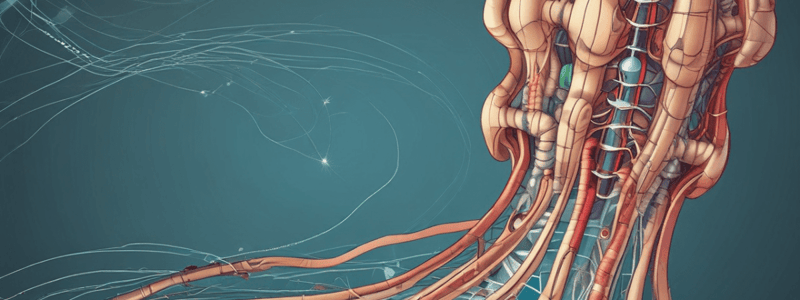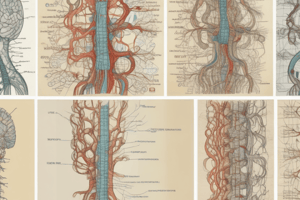Podcast
Questions and Answers
What is the primary function of the spinal cord in relation to the sensory system?
What is the primary function of the spinal cord in relation to the sensory system?
- To process and interpret sensory information
- To generate motor responses to stimuli
- To store and retrieve sensory information
- To receive and distribute information to the PNS (correct)
What is the role of interneurons in the spinal cord's motor system?
What is the role of interneurons in the spinal cord's motor system?
- To integrate sensory and motor functions for reflex activity
- To contain complex neural circuits for motor control (correct)
- To generate motor responses to sensory stimuli
- To transmit motor signals from the brain to the PNS
What is the characteristic of a monosynaptic reflex?
What is the characteristic of a monosynaptic reflex?
- It is a voluntary motor response
- It involves multiple synapses in the CNS
- It has a reflex arc involving contact directly between sensory and motor neurons (correct)
- It requires the integration of sensory and motor functions
What is the purpose of testing reflexes in a clinical setting?
What is the purpose of testing reflexes in a clinical setting?
What is the function of the spinal cord in relation to motor control?
What is the function of the spinal cord in relation to motor control?
What is the definition of a reflex?
What is the definition of a reflex?
What is the function of the reflex arc?
What is the function of the reflex arc?
What is the primary characteristic of a segmental reflex arc?
What is the primary characteristic of a segmental reflex arc?
What is the characteristic of a polysynaptic reflex?
What is the characteristic of a polysynaptic reflex?
What is the main action of the patellar reflex?
What is the main action of the patellar reflex?
What is the type of effector organ involved in an autonomic reflex?
What is the type of effector organ involved in an autonomic reflex?
What is the term for the relaxation of an antagonistic muscle while the other muscle is contracting?
What is the term for the relaxation of an antagonistic muscle while the other muscle is contracting?
Which of the following reflexes is an example of a stretch reflex?
Which of the following reflexes is an example of a stretch reflex?
What is the primary characteristic of an intersegmental reflex arc?
What is the primary characteristic of an intersegmental reflex arc?
What are the spinal cord segments involved in the patellar reflex?
What are the spinal cord segments involved in the patellar reflex?
What is the term for the reflex that involves afferent axons going from a muscle stretch receptor to directly synapse with spinal cord alpha motor neurons?
What is the term for the reflex that involves afferent axons going from a muscle stretch receptor to directly synapse with spinal cord alpha motor neurons?
What is the primary function of the inverse stretch reflex?
What is the primary function of the inverse stretch reflex?
What is the effect of the golgi tendon organ reflex on the duration and force of muscle contraction associated with the stretch reflex?
What is the effect of the golgi tendon organ reflex on the duration and force of muscle contraction associated with the stretch reflex?
What is the secondary action of the inverse stretch reflex?
What is the secondary action of the inverse stretch reflex?
What is the role of the receptor in the golgi tendon organ reflex?
What is the role of the receptor in the golgi tendon organ reflex?
What is the characteristic of the flexor reflex in response to a noxious stimulus?
What is the characteristic of the flexor reflex in response to a noxious stimulus?
What is the mechanism of the flexor reflex?
What is the mechanism of the flexor reflex?
What is the main action of the inverse stretch reflex?
What is the main action of the inverse stretch reflex?
What is the characteristic of reciprocal innervation in the flexor reflex?
What is the characteristic of reciprocal innervation in the flexor reflex?
Which of the following is NOT a primary function of the Upper Motor Neurons (UMNs)?
Which of the following is NOT a primary function of the Upper Motor Neurons (UMNs)?
What is the result of loss of inhibitory UMN influence on Lower Motor Neurons (LMNs)?
What is the result of loss of inhibitory UMN influence on Lower Motor Neurons (LMNs)?
Which of the following is a characteristic of Lower Motor Neurons (LMNs)?
Which of the following is a characteristic of Lower Motor Neurons (LMNs)?
What is the primary function of the corticomedullary pathway?
What is the primary function of the corticomedullary pathway?
Which of the following is a sign of a Lower Motor Neuron (LMN) lesion?
Which of the following is a sign of a Lower Motor Neuron (LMN) lesion?
What is the primary location of the Lower Motor Neurons (LMNs) that innervate the limbs?
What is the primary location of the Lower Motor Neurons (LMNs) that innervate the limbs?
What is the clinical significance of an intact reflex?
What is the clinical significance of an intact reflex?
Which of the following is a characteristic of Upper Motor Neurons (UMNs)?
Which of the following is a characteristic of Upper Motor Neurons (UMNs)?
What is the effect of a lesion at C1-C5 on the muscle tone of the thoracic limb?
What is the effect of a lesion at C1-C5 on the muscle tone of the thoracic limb?
A lesion at T3-L3 affects the muscle tone of which limb?
A lesion at T3-L3 affects the muscle tone of which limb?
What is the characteristic posture of Schiff-Sherrington posture?
What is the characteristic posture of Schiff-Sherrington posture?
What is the cause of Schiff-Sherrington posture?
What is the cause of Schiff-Sherrington posture?
A lesion at L4-S3 affects the muscle tone of which limb?
A lesion at L4-S3 affects the muscle tone of which limb?
What is the effect of a lesion at CD1-CD5 on the muscle tone of the thoracic limb?
What is the effect of a lesion at CD1-CD5 on the muscle tone of the thoracic limb?
What is the prognosis of Schiff-Sherrington posture in underlying disease?
What is the prognosis of Schiff-Sherrington posture in underlying disease?
What is the typical cause of spinal trauma leading to Schiff-Sherrington posture?
What is the typical cause of spinal trauma leading to Schiff-Sherrington posture?
Flashcards are hidden until you start studying
Study Notes
Spinal Cord Function
- The spinal cord receives and distributes sensory information to the peripheral nervous system (PNS) and relays afferent/sensory information to brain centers.
- The spinal cord integrates sensory and motor functions for reflex activity, both within a limb and between limbs.
- The spinal cord relays efferent/motor information from motor management centers to connect with lower motor neurons (LMN) and contains interneuron and complex neural circuits for motor control.
Reflex Activity
- A reflex is an involuntary, qualitatively unvarying motor response of the nervous system to a stimulus.
- A reflex arc contains five fundamental components: a receptor, sensory neuron, one or more synapses in the CNS, a motor neuron, and a target organ.
- A reflex always returns some condition of the body back to the desired state.
Reflex Classification
- Reflexes can be classified as monosynaptic or polysynaptic, based on the presence or absence of interneurons.
- Reflexes can be classified as ipsilateral or contralateral, based on the location of the reflex arc.
- Reflexes can be classified as segmental or intersegmental, based on the extent of the spinal cord or brainstem involved.
- Reflexes can be classified as somatic or autonomic, based on the type of effector organ involved.
Stretch Reflex
- A stretch reflex is a monosynaptic reflex that responds to muscle stretching, causing muscle contraction.
- The stretch reflex involves afferent axons going from a muscle stretch receptor to directly synapse with spinal cord alpha motor neurons, which cause contraction of that same muscle.
- The patellar reflex is an example of a stretch reflex, testing the stretch reflex mediated by the femoral nerve.
Inverse Stretch Reflex
- The inverse stretch reflex, also known as the golgi tendon organ reflex, has the major goal of preventing excessive tension on the muscle, in response to muscle contraction.
- The receptor is sensitive to muscle tension, increasing its firing rate when the muscle contracts, which can excite an inhibitory interneuron in the spinal cord, inhibit the alpha motor neuron, and lead to muscle relaxation.
Flexor Reflex
- The flexor reflex is a coordinated polysynaptic reflex in which all the flexor muscles of the limb contract in response to a noxious stimulus.
- The flexor reflex involves alpha motor neuron stimulation, while those to the extensor muscles are inhibited, due to reciprocal innervation.
Upper Motor Neurons (UMN)
- UMN's initiate, regulate, modify, and terminate the activity of lower motor neurons (LMN).
- UMN's may inhibit or facilitate LMN.
- Loss of inhibitory UMN results in increased muscle tone and spinal reflexes.
- Loss of facilitatory UMN results in paresis or paralysis.
Lower Motor Neurons (LMN)
- LMN have their cell bodies in the CNS (brainstem or spinal cord), while their axons project into the PNS via cranial or spinal nerves, connecting with skeletal muscle at the neuromuscular junction.
- When stimulated, LMN's induce muscle contraction.
- Muscle tone and bulk depend on LMN function.
- Loss of LMN's results in paresis/paralysis, with decreased to absent muscle tone and reflexes.
UMN vs LMN: Signs
- Clinically, an intact reflex, be it normal or exaggerated, tells the clinician that the lesion does NOT involve that area of the CNS or PNS.
Spinal Cord Lesion Localization: Exception
- Schiff-Sherrington posture occurs due to interruption of inhibitory neuron input from the lumbar spinal cord, characterized by rigid forelimb extension with normal function, with concurrent hindlimb paresis and paralysis.
- This posture is NOT associated with prognosis of the underlying disease.
Studying That Suits You
Use AI to generate personalized quizzes and flashcards to suit your learning preferences.




